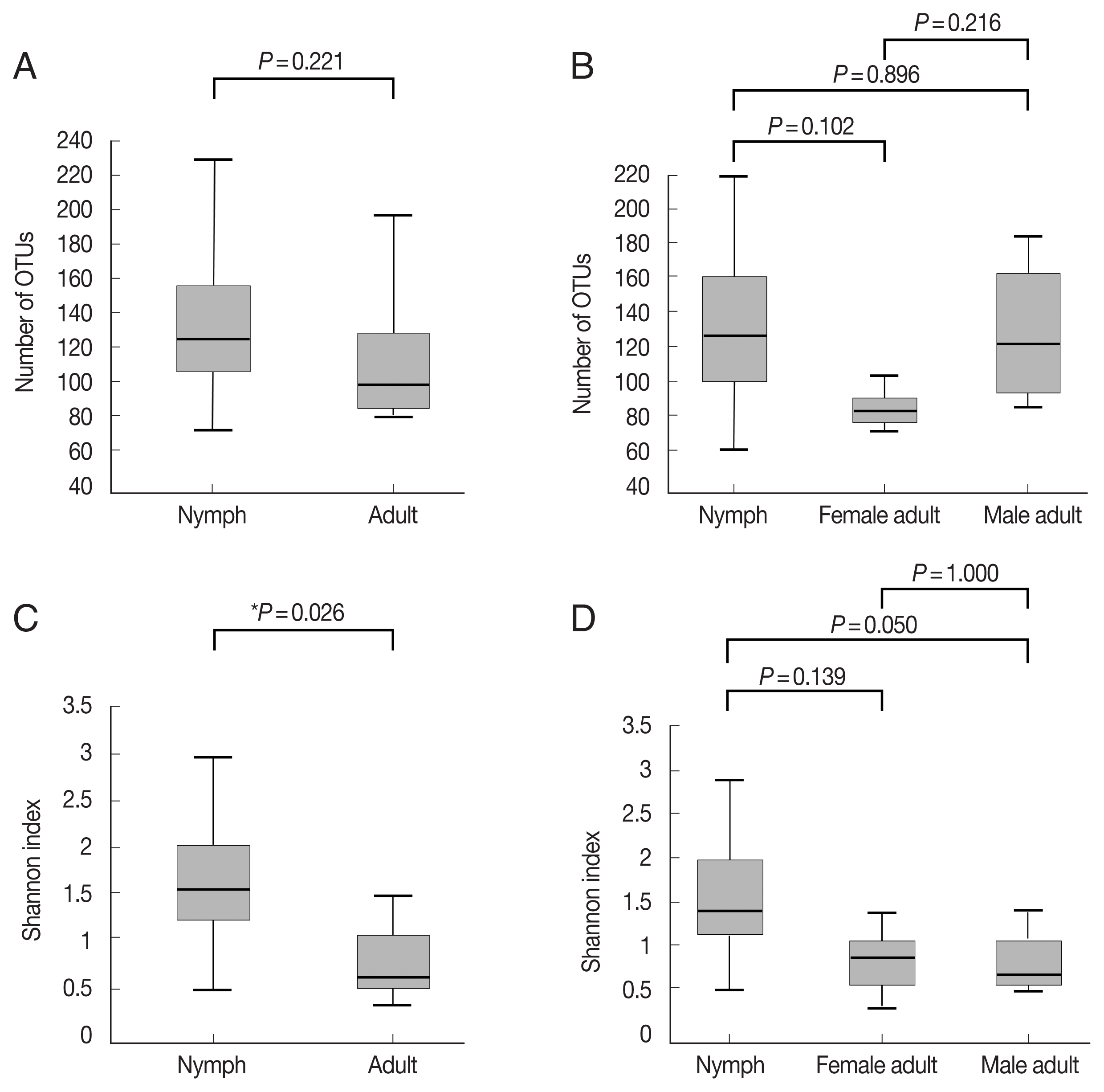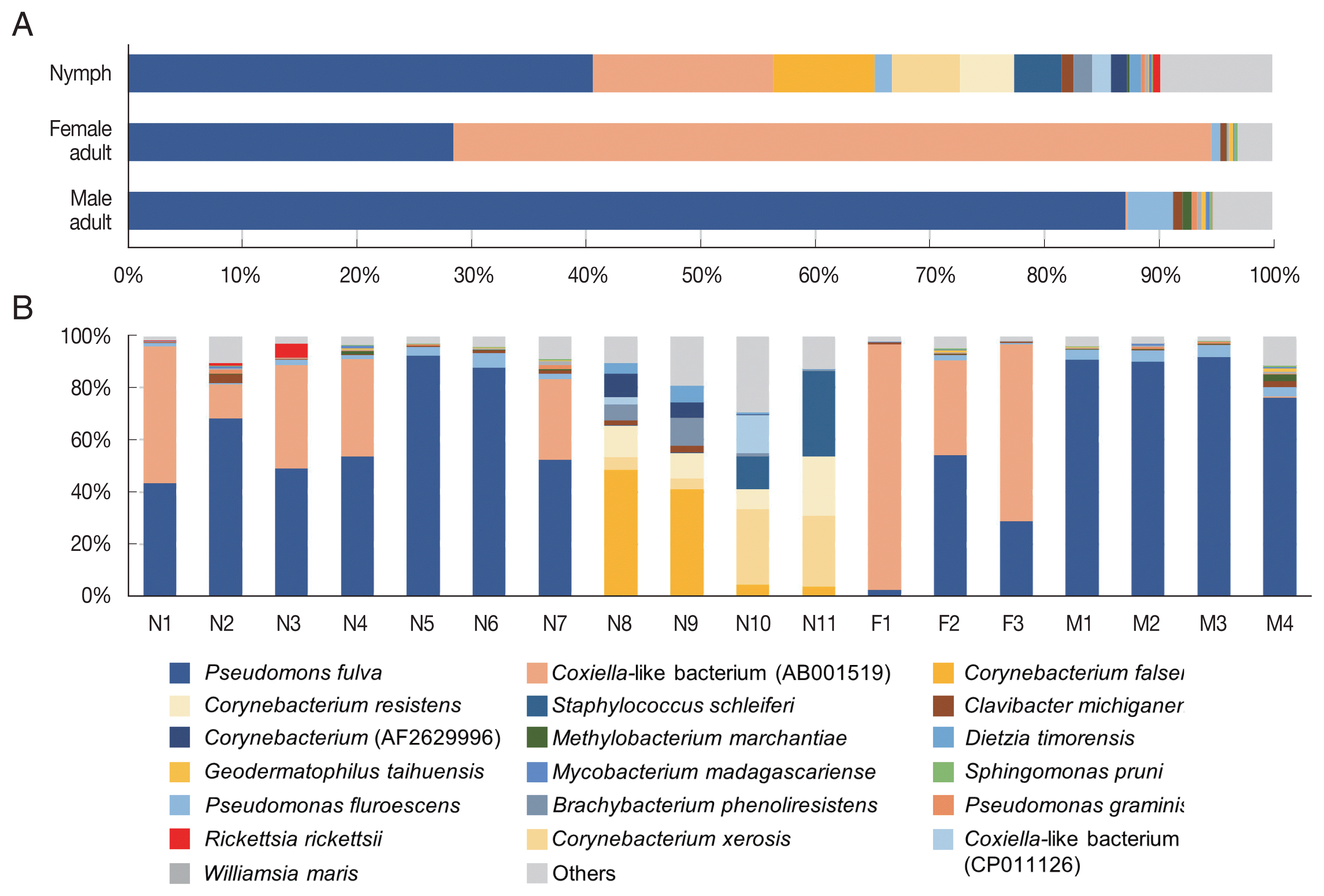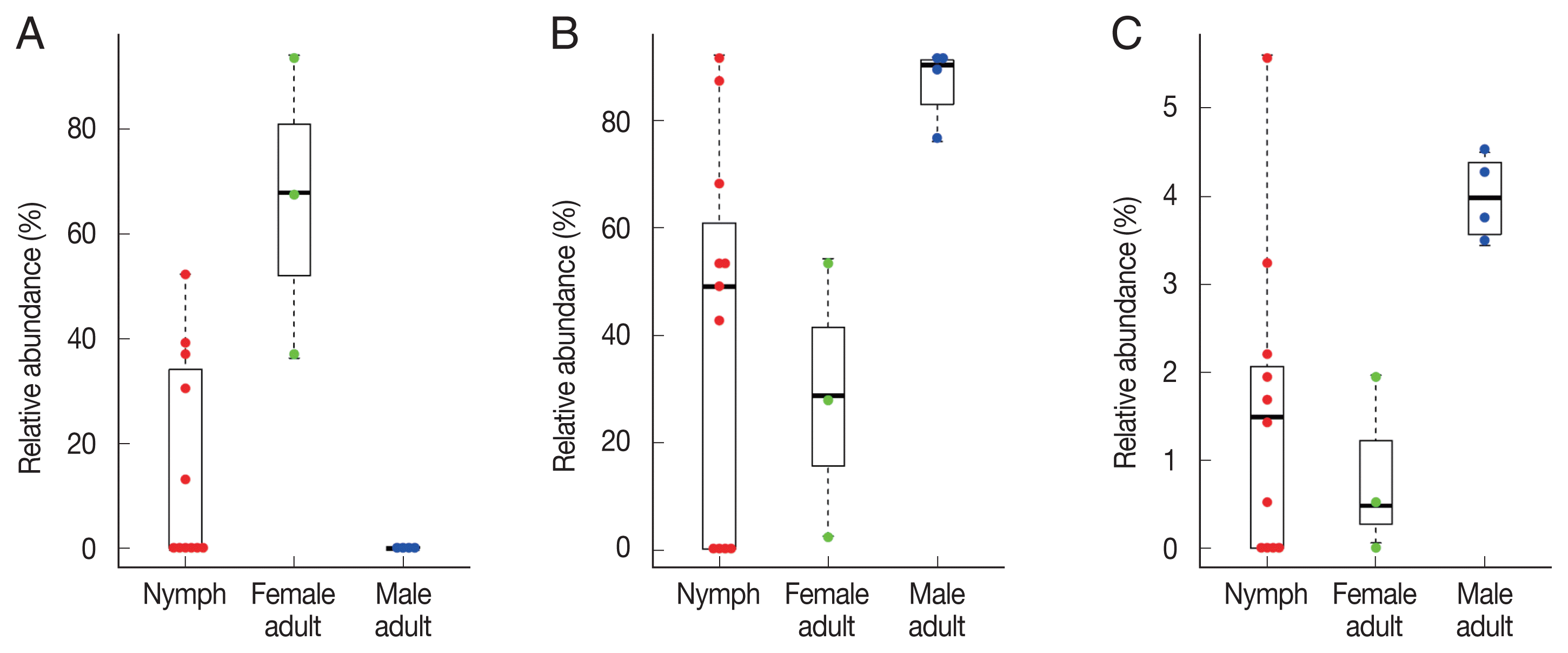2. Roy BC, Estrada-Peña A, Krücken J, Rehman A, Ard Menzo Nijhof AM. Morphological and phylogenetic analyses of
Rhipicephalus microplus ticks from Bangladesh, Pakistan and Myanmar.
Ticks Tick Borne Dis 2018;9:1069-1079
https://doi.org/10.1016/j.ttbdis.2018.03.035


3. Wormser GP, Mckenna D, Piedmonte N, Vinci V, Egizi AM, Backenson B, Falco RC. First recognized human bite in the United States by the Asian Longhorned Tick,
Haemaphysalis longicornis.
Clin Infect Dis 2020;70:314-316
https://doi.org/10.1093/cid/ciz449


5. Hoogstraal H, Roberts FH, Kohls GM, Tipton VJ. Review of
Haemaphysalis (
Kaiseriana)
longicornis Neumann (resurrected) of Australia, New Zealand, New Caledonia, Fiji, Japan, Korea, and Northeastern China and USSR, and its parthenogenetic and bisexual populations (Ixodoidea, Ixodidae).
J Parasitol 1968;54:1197-1213
https://doi.org/10.2307/3276992


6. White SA, Bevins SN, Ruder MG, Shaw D, Vigil SL, Randall A, Deliberto TJ, Dominguez K, Thompson AT, Mertins JW, Alfred JT, Yabsley MJ. Surveys for ticks on wildlife hosts and in the environment at Asian longhorned tick (
Haemaphysalis longicornis)-positive sites in Virginia and New Jersey, 2018.
Transbound Emerg dis 2021;68:605-614
https://doi.org/10.1111/tbed.13722


7. de la Fuente J, Estrada-Pena A, Venzal JM, Kocan KM, Sonenshine DE. Overview: Ticks as vectors of pathogens that cause disease in humans and animals.
Front Biosci 2008;13:6938-6946
https://doi.org/10.2741/3200


9. Kim JY, Kim EM, Yi MH, Lee JY, Lee SW, Hwang YJ, Yong DE, Sohn WM, Yong TS. Chinese liver fluke Clonorchis sinensis infection changes the gut microbiome and increases probiotic
Lactobacillus in mice.
Parasitol Res 2019;118:693-699
https://doi.org/10.1007/s00436-018-6179-x


12. Schloss PD, Westcott SL, Ryabin T, Hall JR, Hartmann M, Hollister EB, Lesniewski RA, Oakley BB, Parks DH, Robinson CJ, Sahl JW, Stres B, Thallinger GG, Van Horn DJ, Weber CF. Introducing mothur: open-source, platform-independent, community supported software for describing and comparing microbial communities.
Appl Environ Microbiol 2009;75:7537-7541
https://doi.org/10.1128/AEM.01541-09

13. Yoon SH, Ha SM, Kwon SJ, Lim JM, Kim YS, Seo HS, Chun JS. Introducing EzBioCloud: a taxonomically united database of 16S rRNA gene sequences and whole-genome assemblies.
Int J Syst Evol Microbiol 2017;67:1613-1617
https://doi.org/10.1099/ijsem.0.001755



20. Sneath PHA, Sokal RR. Numerical Taxonomy—the Principles and Practice of Numerical Classification. San Francisco, USA. W. H. Freeman. 1973,
https://doi.org/10.2307/2412767

25. Chae JB, Cho YS, Cho YK, Kang JG, Shin NS, Chae JS. Epidemiological Investigation of Tick Species from Near Domestic Animal Farms and Cattle, Goat, and Wild Boar in Korea.
Korean J Parasitol 2019;57:319-324
https://doi.org/10.3347/kjp.2019.57.3.319



26. Lee JH, Park HS, Jang WJ, Koh SE, Park TK, Kang SS, Kim BJ, Kook YH, Park KH, Lee SH. Identification of the
Coxiella sp. detected from
Haemaphysalis longicornis ticks in Korea.
Microbiol Immunol 2004;48:125-130
https://doi.org/10.1111/j.1348-0421.2004.tb03498.x


27. Rosenberg R, Lindsey NP, Fischer M, Gregory CJ, Hinckley AF, Mead PS, Paz-Bailey G, Waterman SH, Drexler NA, Kersh GJ, Hooks H, Partridge SK, Visser SN, Beard CB, Petersen LR. Vital signs: trends in reported vectorborne disease cases - United States and Territories, 2004–2016.
MMWR Morb Mortal Wkly Rep 2018;67:496-501
https://doi.org/10.15585/mmwr.mm6717e1



28. Chicana B, Couper LI, Kwan JY, Tahiraj E, Swei A. Comparative Microbiome Profiles of Sympatric Tick Species from the Far-Western United States.
Insects 2019;10:353
https://doi.org/10.3390/insects10100353


29. Ruiling Z, Zhendong H, Guangfu Y, Zhong Z. Characterization of the bacterial community in
Haemaphysalis longicornis (Acari: Ixodidae) throughout developmental stages.
Exp Appl Acarol 2019;77:173-186
https://doi.org/10.1007/s10493-019-00339-7


30. Zolnik CP, Prill RJ, Falco RC, Daniels TJ, Kolokotronis SO. Microbiome changes through ontogeny of a tick pathogen vector.
Mol Ecol 2016;25:4963-4977
https://doi.org/10.1111/mec.13832


32. Rahal M, Medkour H, Diarra AZ, Bitam I, Parola , Mediannikov O. Molecular identification and evaluation of
Coxiella-like endosymbionts genetic diversity carried by cattle ticks in Algeria.
Ticks Tick Borne Dis 2020;11:101493
https://doi.org/10.1016/j.ttbdis.2020.101493


33. Duron O. The IS1111 insertion sequence used for detection of
Coxiella burnetii is widespread in
Coxiella-like endosymbionts of ticks. FEMS Microbiol Lett; 2015. 362:fnv132
https://doi.org/10.1093/femsle/fnv132


35. Rudolf I, Mendel J, Šikutová S, Svec P, Masaríková J, Nováková D, Bunková L, Sedlácek I, Hubálek Z. 16S rRNA gene-based identification of cultured bacterial flora from host-seeking Ixodes ricinus, dermacentor reticulatus and haemaphysalis concinna ticks, vectors of vertebrate pathogens.
Folia Microbiol (Praha) 2009;54:419-428
https://doi.org/10.1007/s12223-009-0059-9


37. Choi YJ, Jang WJ, Kim JH, Ryu JS, Lee SH, Park KH, Paik HS, Koh YS, Choi MS, Kim IS. Spotted fever group and typhus group rickettsioses in humans, South Korea.
Emerg Infect Dis 2005;11:237-244
https://doi.org/10.3201/eid1102.040603



38. Lee JH, Park HS, Jung KD, Jang WJ, Koh SE, Kang SS, Lee IY, Lee WJ, Kim BJ, Kook YH, Park KH, Lee SH. Identification of spotted fever group rickettsiae detected from
Haemaphysalis longicornis in Korea.
Microbiol Immunol 2003;47:301-304
https://doi.org/10.1111/j.1348-0421.2003.tb03399.x


39. Choi YJ, Lee EM, Park JM, Lee KM, Han SH, Kim JK, Lee SH, Song HJ, Choi MS, Kim IS, Park KH, Jang WJ. Molecular detection of various rickettsiae in mites (Acari: trombiculidae) in southern Jeolla Province, Korea.
Microbiol Immunol 2007;51:307-312
https://doi.org/10.1111/j.1348-0421.2007.tb03912.x


41. Lee SH, Lee JH, Park SD, Lee HK, Hwang SD, Jeong HW, Heo JY, Lee YS. Isolation of
Coxiella burnetii in patients with nonspecific febrile illness in South Korea.
BMC Infect Dis 2020;20:421
https://doi.org/10.1186/s12879-020-05130-3



42. Ouh IO, Seo MG, Do JC, Kim IK, Cho MH, Kwak DM. Seroprevalence of
Coxiella burnetii in bulk-tank milk and dairy cattle in Gyeongbuk province, Korea.
Korean J Vet Serv 2013;36:243-248 (in Korean).
https://doi.org/10.7853/kjvs.2013.36.4.243

43. Ooshiro M, Zakimi S, Matsukawa Y, Katagiri Y, Inokuma H. Detection of
Anaplasma bovis and
Anaplasma phagocytophilum from cattle on Yonaguni Island, Okinawa, Japan.
Vet Parasitol 2008;154:360-364
https://doi.org/10.1016/j.vetpar.2008.03.028


45. Lee M, Yu D, Yoon J, Li Y, Lee J, Park J. Natural co-infection of
Ehrlichia chaffeensis and
Anaplasma bovis in a deer in South Korea.
J Vet Med Sci 2009;71:101-103
https://doi.org/10.1292/jvms.71.101


46. Kang JG, Ko S, Kim YJ, Yang HJ, Lee H, Shin NS, Choi KS, Chae JS. New genetic variants of
Anaplasma phagocytophilum and
Anaplasma bovis from Korean water deer (
Hydropotes inermis argyropus).
Vector Borne Zoonotic Dis 2011;11:929-938
https://doi.org/10.1089/vbz.2010.0214


47. Lee MJ, Chae JS. Molecular detection of
Ehrlichia chaffeensis and
Anaplasma bovis in the salivary glands from
Haemaphysalis longicornis ticks.
Vector Borne Zoonotic Dis 2010;10:411-413
http://doi.org/10.1089/vbz.2008.0215


48. Doan HT, Noh JH, Choe SE, Yoo MS, Kim YH, Reddy KE, Quyen DV, Nguyen LT, Nguyen TT, Kweon CH, Jung SC, Chang KY, Kang SW. Molecular detection and phylogenetic analysis of
Anaplasma bovis from
Haemaphysalis longicornis feeding on grazing cattle in Korea.
Vet Parasitol 2013;196:478-481
https://doi.org/10.1016/j.vetpar.2013.03.025







